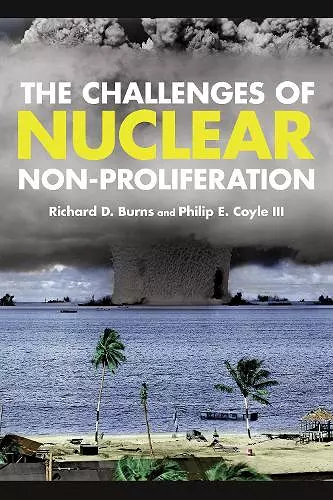The Challenges of Nuclear Non-Proliferation
Richard Dean Burns author Hon Philip E Coyle author
Format:Hardback
Publisher:Bloomsbury Publishing PLC
Published:12th Mar '15
Currently unavailable, and unfortunately no date known when it will be back
This hardback is available in another edition too:
- Paperback£36.00(9781442223752)

The Challenges of Nuclear Non-Proliferation is an exhaustive survey of the many aspects of non-proliferation efforts. It explains why some nations pursued nuclear programs while others abandoned them, as well as the challenges, strengths, and weaknesses of non-proliferation efforts. It addresses key issues such as concerns over rogue states and stateless rogues, delivery systems made possible by technology, and the connection between nuclear weapons and ballistic missiles, examining whether non-proliferation regimes can deal with these threats or whether economic or military sanctions need to be developed. It also examines the feasibility of eliminating or greatly reducing the number of nuclear weapons. A broad survey of one of today’s great threats to international security, this text provides undergraduates students with the tools needed to evaluate current events and global threats.
This book provides a descriptive summary of international efforts to limit the spread of nuclear weapons over the past 70 years. Deliberately rejecting a theoretically informed analysis, the authors instead offer a historical survey of the evolution of various components of the modern nuclear nonproliferation regime. Although presenting the work as a factual account, Burns (emer., history, California State Univ., Los Angeles) and Coyle (formerly, White House Office of Science and Technology Policy) at times introduce ideological positions into the narrative that detract from the work’s objectivity. Relying mainly on secondary sources and offering no new interpretations of events, the authors essentially have written an up-to-date primer for those new to the study of nuclear nonproliferation. . . .Summing Up: Recommended. Lower-division undergraduate collections. * Choice Reviews *
[T]he authors have packed quite a bit of high quality and somber material into a short book. This book provides a useful account of the decisions and actors that have characterized the international efforts to rein in the spread of nuclear weapons since 1945…. Their writing style is serious and conveys important concepts in a well-organized manner that allows them to avoid dragging readers into heavy details that often characterize works of this nature…. The book relies on widely available materials and provides links to the obscure ones. The bibliographic entries are solid and compressive in scope. Nearly every reader will learn something new, whether it is about the evolution of the non-proliferation regime or about the Eisenhower Administration’s Atoms for Peace program, or any number of other interesting facts. The text seems ideal for advanced courses in international history or politics. It assumes that readers have a basic knowledge of world politics in the Post-WWII period. It would be a strong supplemental reading for advanced undergraduate or graduate courses in international security courses. It provides an often-ignored perspective on the Cold War…. The book raises intriguing questions and provides materials for the readers to address… Most impressive is that despite the book’s 2015 publication date, it does not seem outdated. * International Social Science Review *
The Challenges of Nuclear Non-Proliferation joins others in Rowman and Littlefield's 'Weapons of Mass Destruction' series to survey the many aspects of non-proliferation agreements and how they work - or don't work. It reviews nuclear programs in different countries and their different approaches, considers rogue states and technological advancements in delivery and nuclear systems, analyzes the political and economic influences behind decision-making processes, and in general reviews the key issues involved in worldwide nuclear security. No student of nuclear arms issues should be without this hard-hitting discussion. * Midwest Book Review *
The world is not a mess, it's just messy. Burns and Coyle superbly describe how smart strategies contained and rolled back the nuclear mess poor policy choices created over the decades. Read it. You'll feel more hopeful and a whole lot smarter. -- Joe Cirincione, president of Ploughshares Fund, a global security foundation
Richard Dean Burns and Philip E. Coyle, two of the world's foremost authorities on nuclear weapons, have produced in this book a hugely impressive commentary on the basic elements that have influenced non-proliferation, beginning with the history of nuclear weapons and the race by the five original nuclear weapons states, followed by the course and consequences of the Non-Proliferation Treaty, concluding with an assessment of where nuclear non-proliferation stands today. The result is an eminently readable, carefully crafted, and ultimately satisfying account of one of the most important issues in the world today. All politicians and their advisers should give this work a careful read as they consider how their policies will enhance or inhibit the development of a more stable world. -- Joseph M. Siracusa, Deputy Dean of Global Studies, The Royal Melbourne Institute of Technology University
The authors, Richard Burns and Dr. Philip Coyle, take the reader on a grand tour of the Nuclear Non-proliferation Regime, built over the years on the Nuclear Non-proliferation Treaty. It is a tour worth taking. A very impressive work. -- Thomas Graham, former Special Representative of the President for Arms Control, Non-proliferation and Disarmament
ISBN: 9781442223745
Dimensions: 237mm x 158mm x 23mm
Weight: 494g
254 pages